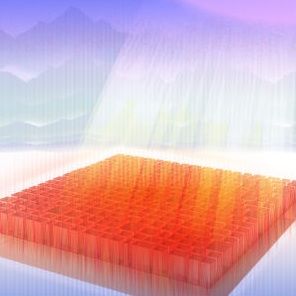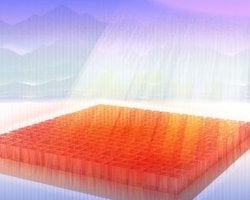An international group led by the Universities of York and St Andrews in the UK has found a way to improve solar cells so they convert more solar energy into electricity.
To convert solar energy into electricity you need solar cells. These are essentially thin disks of a semiconductor like silicon attached to a circuit. As light hits the disk, it is converted into electricity that flows through the circuit.
A key challenge in solar power engineering is improving the efficiency of solar cells so they capture as much light as possible to convert into electrical power.
In a new study that they report in Nature Communications, British, Chinese and Belgian teams describe how they developed a possible way to increase the efficiency of solar cells.
The approach traps more broad-band light in thin films, potentially giving solar cell designers a way to convert more light into electricity.
Nanophotonics
The work is at the forefront of a field known as “nanophotonics”, where scientists study the interaction of light with various materials at the nano or atomic scale.
Discoveries in this field are exciting because materials can behave quite differently at this scale, resulting in new optical properties.
Nanophotonics scientists looking at solar power applications are particularly interested in a class of materials known as “quasi-crystals” because of the potentially broad bands of light they can capture – something that specialists call their “Fourier spectra.”

But quasi-crystals aren’t easy to work with, mainly because of the lack of design tools for manipulating the bands of light or Fourier spectra they can capture.
In this new study, the international group describes an approach based on “binary gratings” whereby they created new “quasi-random nanostructures” that allowed them to control the material’s Fourier components “almost at will.”
They write that the approach “makes the structures easy to replicate and to tailor towards specific applications.”
And they give an example of how the method can trap light in thin films at an efficiency that is so high it approaches the theoretical limit.
Applying nanophotonics design ideas to solar cells
One of the study leaders, Dr Thomas F Krauss, an Anniversary Professor in the Department of Physics at the University of York, says:
“Applying our nanophotonics design ideas to such an important area as solar cells is essential for improving the competitiveness of renewable energy generation.”
Corresponding author Dr Juntao Li of Sun Yat-sen University in China, adds:
“Other than solar cells, our design can also be used in many light trapping areas, like LED and DFB lasers.”
Funds from the Scottish Universities Physics Alliance (SUPA), the National Key Basic Research Special Foundation, the National Natural Science Foundation of China and Guangdong Natural Science Foundation helped finance the research.

